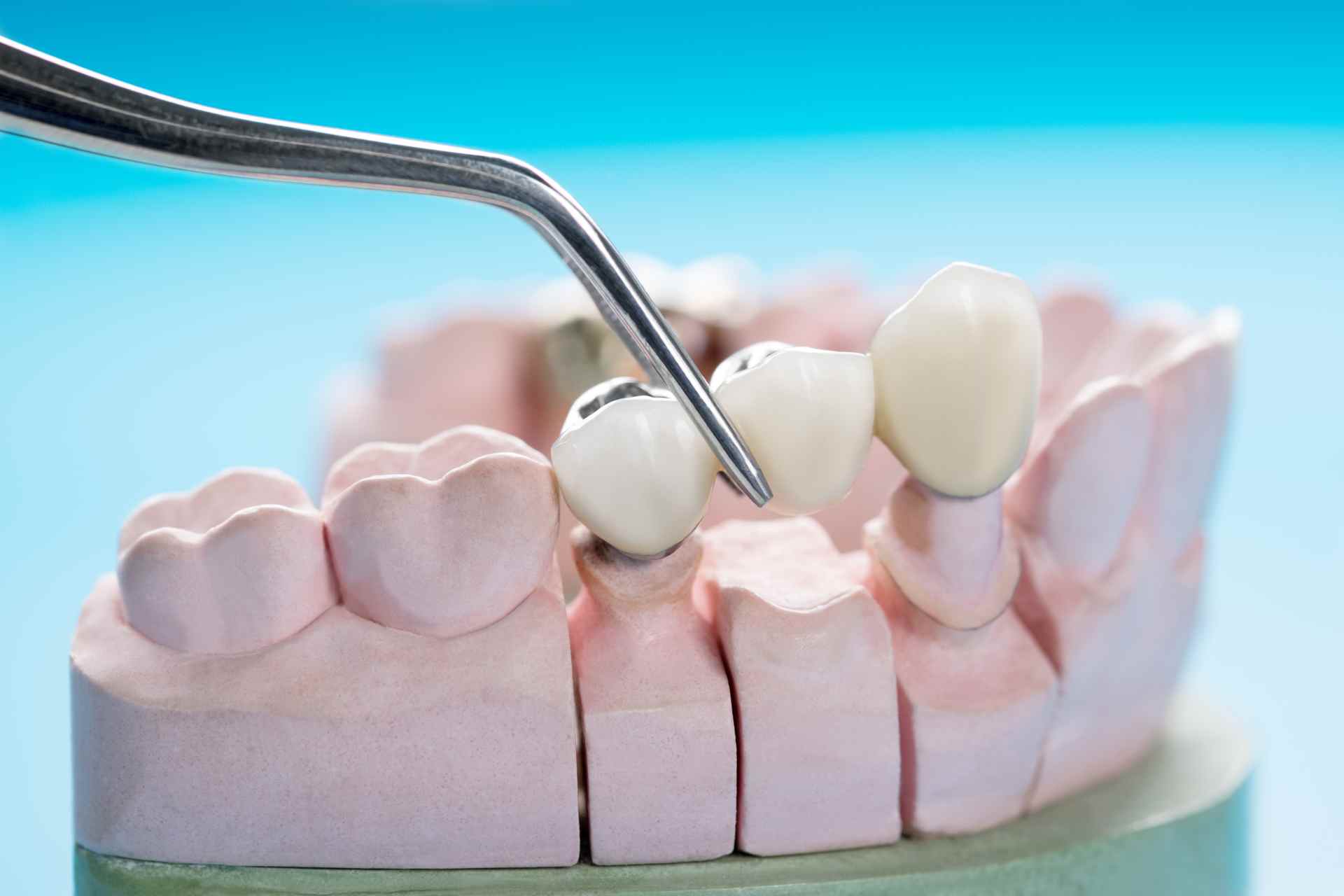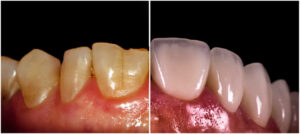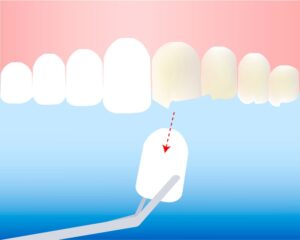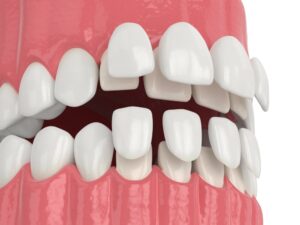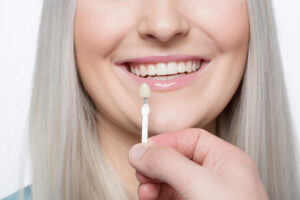Today’s post will be dedicated to talking about the fixed dental bridge. The fixed dental bridge is also called a fixed partial prosthesis, and it is a type of dental prosthesis that helps the patient to recover both the functionality of chewing and oral aesthetics. It is one of the best options to apply in cases where several adjacent or continuous teeth are missing.
Follow us until the end of this article if you want to know all the details about the dental fixed bridge: what it is, what types of dental fixed bridge currently exist, its differences with respect to the removable dental bridge, how to clean and maintain it, how much it costs, how long it lasts once put on, and many more details.
What is a fixed dental bridge
A fixed dental bridge is a type of dental prosthesis whose function is to replace several dental pieces in a row (usually 1 to 3 or 4 consecutive pieces) that the patient has lost. Depending on the type of dental prosthesis, the fixed bridge can be supported by healthy teeth (previously carved or devitalized) that are positioned adjacent to the space left by the missing teeth, or it can be supported on titanium or zirconium dental implants inserted into the mandible or maxilla, as appropriate.
The fixed dental bridge on natural teeth, and especially the fixed dental bridge on implants, are considered the two most satisfactory types of prostheses today in terms of aesthetics, comfort, hygiene, and recovery of oral functionality. In general, all fixed dental bridges are made up of:
- Pillar or abutments : Each of the teeth on which the ends of the fixed dental bridge rest. They must be healthy teeth, without cavities, fractures, or gingivitis, or with a level of sealing and vitality verified by radiography and sufficient to support the fixed bridge without potential health or support problems later.
- Pontics: It is the bridge or artificial tooth.
Types of fixed dental bridge
Although all those that we are going to list are considered variants of fixed dental bridge, they also have their peculiarities that require a separate explanation. As we will see, some of these types of fixed dental bridges are used less and less or have fallen into disuse.
Fixed dental bridge on implants
The essence of this type of fixed dental bridge with respect to the others is the direct integration of the prosthesis with the maxillary bones, an integration that is also called “ osseointegration ”. Titanium or zirconium implants are placed in the jaws, and the dental bridge is anchored to them. Although, unlike the placement of other types of fixed bridge, this requires a certain level of surgery, the results are considered so satisfactory that they become recommendable.
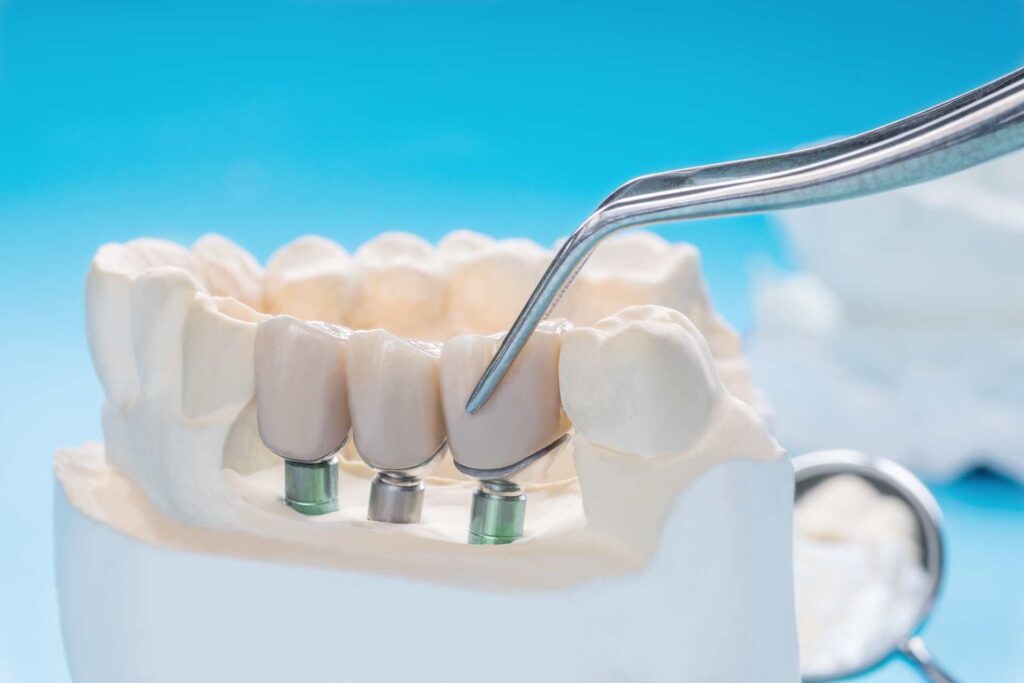
In fact, this is the type of fixed dental bridge that is most recommended today, and one of the most used in practice despite its price. It is true that it is the least economical variant (we will see the price later), but it is the most comfortable, the most hygienic, the most aesthetic, and the one that returns functionality to the mouth with the greatest efficiency.
Fixed dental bridge with carving of adjacent teeth
This type of fixed dental bridge is attached, not to implants, but to some healthy teeth adjacent to the space left by the teeth that the patient lost. As it requires the grinding or devitalization of one or more teeth, it is considered an invasive procedure. However, it is the second most recommended option.
Fixed metal and porcelain dental bridge
This currently coincides with the so-called Maryland Bridge. Previously, this type of bridge combined porcelain in the pieces and metal in the fastening wings.
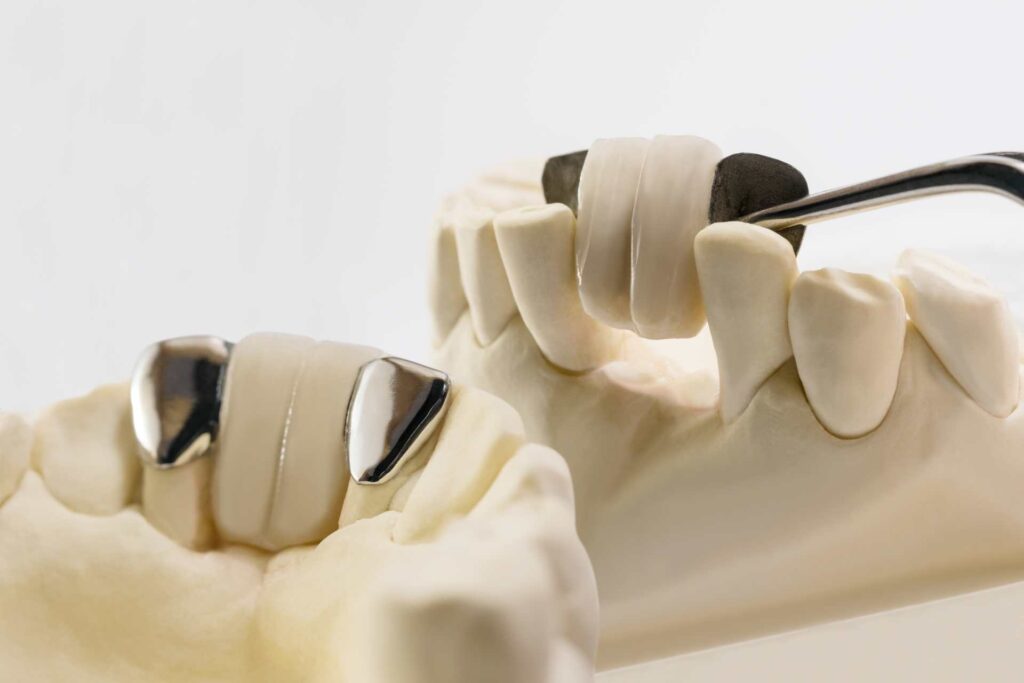
However, today, for the sake of greater aesthetics and functionality, more and more fins are also made of ceramic. The Maryland fixed bridge does not require grinding of healthy teeth, or requires much less, thanks to the fact that the pieces of one end and the other of the bridge incorporate the fixation wing. Only the middle piece does not have a fastening fin.
Cantilever fixed dental bridge
Unlike the dental bridges listed so far, this type of bridge is not made up of 3 pieces but of 2. In the past, it was used a lot, but today it has fallen into disuse because the type of occlusion or bite it promotes is considered potentially destructive due to its leverage effect. Dentists consider it the least desirable of the fixed dental bridge options. Even if the patient cannot afford a more expensive fixed bridge option, the specialist will prefer to recommend a removable dental bridge rather than a cantilever -type fixed dental bridge.
Fixed dental bridge: risks
The use of fixed dental bridges is very common in dental clinics today. Many patients recover the functionality of their teeth thanks to fixed dental bridges. However, this does not mean that this type of dental prosthesis is without risk, especially if we compare fixed dental implants on milled teeth and fixed dental implants on implants.
Although the placement of dental implants requires surgery, it is generally considered less risky than the placement of a fixed dental bridge. The biggest problem of the dental bridge placed on teeth is that it requires filing or carving one or several healthy teeth for the fixation of the prosthesis. This will to some degree permanently affect tooth enamel, which can lead to tooth sensitivity and discomfort.

It must be taken into account that tooth enamel does not recover. Once the tooth is filed, its natural enamel is permanently lost. Dentists themselves consider this an invasive procedure. While it’s a great option for many patients, some doctors have even stopped recommending fixed dental bridges over carved natural teeth. In these cases, they encourage patients to choose the fixed dental bridge on titanium or zirconium implants in the upper jaw or lower jaw.
The specific procedure consists of carving the teeth that are located around the dental space created by the missing teeth. This is used because it is the only way to gain enough space and support to place the fixed dental bridge. To achieve this, it is sometimes necessary to apply the procedure called “tooth devitalization”, which consists of removing the pulp, blood vessels, and nerves of the teeth that will provide support. The carved teeth are called “pillars” because they are what support the bridge.
Dental fixed bridge: price
It is impossible to say where the exact price of a fixed dental bridge, since that depends on the materials, the prices of the clinics, whether or not the patient has insurance, the number of additional procedures that are required in each case, placing the fixed bridge, among other factors.
However, it is estimated that the average price of a fixed dental bridge on milled teeth is 500 euros ($567 USD). But if it were a fixed dental bridge that does not go on carved natural teeth but on implants, the price is much higher: the average price of a fixed dental bridge on implants is about 3,500 euros ($3,972 USD).
In line with the price range of the dental fixed bridge, a logical question is: How long does a fixed dental bridge last? Ultimately, the durability of the fixed dental bridge will determine how often the full treatment will have to be paid for later when the useful life of the prosthesis ends.
A fixed dental bridge on carved teeth is estimated to last 10 to 15 years. On the other hand, normally a fixed dental bridge on implants can last much longer: between 20 and 25 years, although it can last much longer. The durability of the dental fixed bridge will, of course, depend on factors such as:
- The quality of the materials with which the bridge is made.
- The quality of the cement with which the prosthesis is fixed.
- The care of the user on the dental bridge, whether we talk about daily hygiene, revision consultations with the specialist, avoiding biting hard foods, or aggressive chemistry for the material.
- If the user consumes tobacco or alcohol. Both substances include chemical compounds that are harmful not only to the fixed dental bridge but even to any normal denture.

Can a fixed dental bridge be removed?
Usually, a fixed dental bridge is specially designed to be placed and cemented permanently in the mouth. This means that the user himself should not be able to remove it. However, doctors sometimes do temporarily remove the fixed dental bridge in order to deep clean or correct it.
Caring for a fixed dental bridge
Now we will talk specifically about the precautions to be taken with a fixed dental bridge. By following these recommendations, you will lengthen the useful life of this excellent prosthesis as much as possible, so that your comfort is not reduced or your finances are not affected. As will be seen, basically the care of a fixed dental bridge does not differ too much from the care of a normal denture. Although there are special points.
For example, you should brush your teeth after every meal. Currently, specialists also recommend the use of dental floss, not as an option, but as part of normal oral hygiene, at least once a day. If your teeth have spaces between them (whether in the area of the fixed dental bridge or not), it is also recommended to use interdental brushes to achieve optimal cleaning.
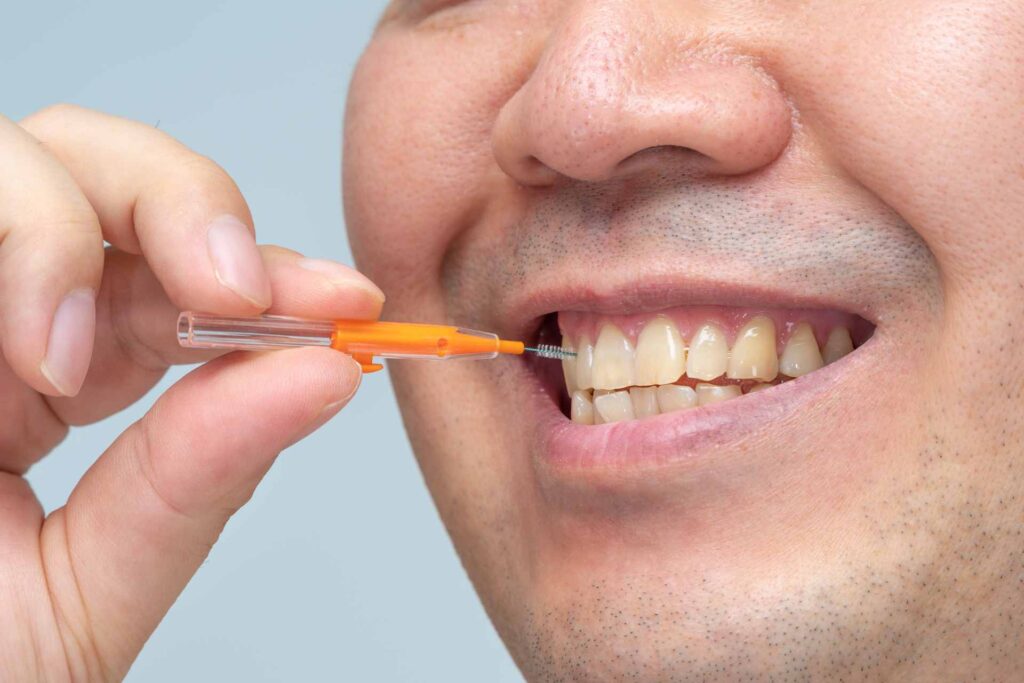
It is good to have dental check-ups once a year with specialists, especially if you are using a fixed dental bridge.
So far the general advice. But, in particular: How to clean a fixed dental bridge? Unlike a removable dental bridge, the fixed dental bridge, as its name suggests, must be cleaned without removing it from the mouth. Some specific care regarding the fixed dental bridge are:
- Use a toothbrush with bristles of medium hardness, neither too soft nor too hard.
- When moving the toothbrush during cleaning, always follow the direction from gum to tooth in a vertical direction, emphasizing the tooth-gum junction. Never brush horizontally or laterally.
- During cleaning, pay special attention to the teeth that support the bridge, as they are the foundation for everything else. Any discomfort in the area may be an indication that food has been left in a gap and must be removed.
- Perhaps you should not use toothpaste or products that include tooth whiteners, since they are usually quite aggressive with normal teeth, and how much more so with fixed dental bridges.
- In any case, check with your dentist which oral hygiene products are best for you to use, now that you use a fixed dental bridge, and if it is convenient for you to use special products.
- As we said above, sometimes, even if it is a fixed dental bridge, the dentist can disassemble the prosthesis to perform a deep cleaning in the clinic. Ask your specialist if this is necessary in your case.
- There is an oral hygiene device called “dental irrigator”, which is very useful for cleaning not only normal teeth but even dental prostheses. Its operation is based on launching a relatively strong pressurized water jet, which cleans interdental spaces quite effectively.
- At home it is important to clean the interdental areas that may be in the fixed dental bridge, using an interdental brush or dental floss of the appropriate caliber. If necessary, ask your dentist to choose the best toothbrush or dental floss that best suits your case.

Which is better: a fixed or removable dental bridge?
The fixed dental bridge is the one that we have been analyzing in this article, that is, the one that is placed permanently on the teeth. The removable dental bridge is, instead, a prosthesis that the user can put on or take off at any time. People often wonder which is better, a fixed or a removable dental bridge. And the answer to this question is: that it more or less depends.
Users of fixed dental bridges assert that the comfort of this type of prosthesis is so great that they often forget they are wearing it. And from an aesthetic point of view, the fixed dental bridge emulates natural teeth very well. The disadvantage of the fixed dental bridge lies in its price. It is more expensive than a removable dental bridge. The removable dental bridge is less aesthetic and less comfortable (you have to remove it to wash it and to sleep), but it is a cheaper option.
If you can access the fixed dental bridge, it may be better to go directly for it. Your dentist will be able to assess your case and tell you if a fixed or removable dental bridge is better for you. However, it is likely that the specialist himself will recommend it to you because in this way you recover full oral functionality. However, if at the moment you cannot access the fixed dental bridge, you also have the option of first placing a removable dental bridge, and later placing the fixed one.
